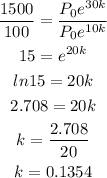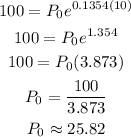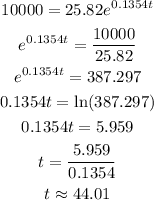Given:
The population was 100 after 10 mins.
The population was 1500 after 30 mins.
To fill the blanks:
Step-by-step explanation:
According to the problem, we write,

Dividing equation (2) by equation (1), we get

So, the equation becomes,

a) To find: The initial population
When P = 100 and t = 10, then the initial population would be,

Therefore, the initial population is 25.82.
b) To find: The doubling time
Using the formula,

The doubling time is 5.12 mins.
c) To find: The population after 65 mins
Substituting t = 65 and the initial population is 25.82 in equation (3) we get,

Therefore, the population after 65 mins is 171467.56.
d) To find: The time taken for the population to reach 10000
Substituting P = 10000 and the initial population is25.82 in equation (3) we get,

Therefore, the time taken for the population to reach 10000 is 44.01 mins.
Final answer:
• The initial population is 25.82.
,
• The doubling time is 5.12 mins.
,
• The population after 65 mins is 171467.56.
,
• The time taken for the population to reach 10000 is 44.01 mins.